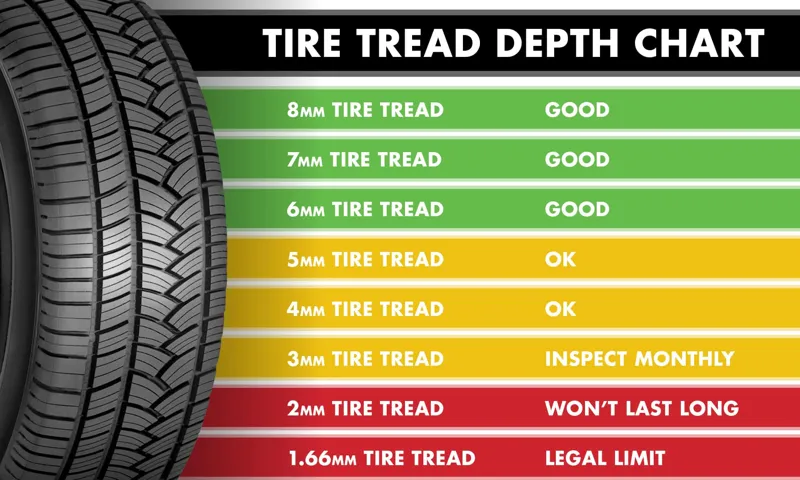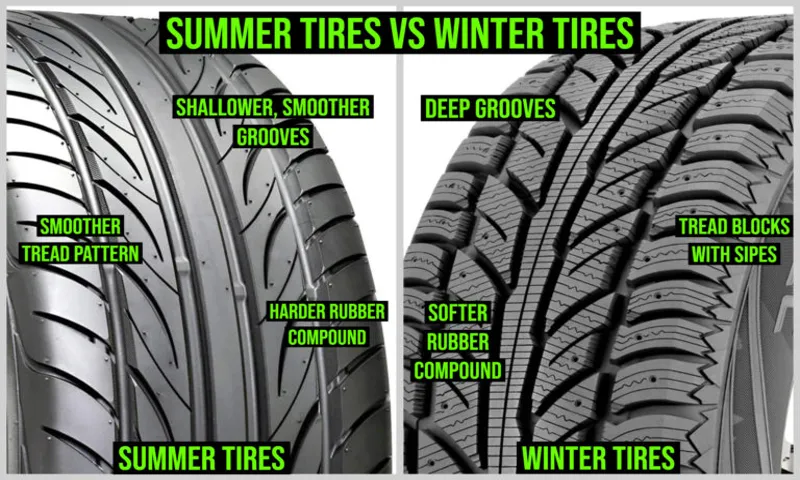As a driver, have you ever wondered why your car’s tires heat up after a long drive? Tire temperature while driving is an essential factor that can affect the overall performance of your vehicle. In fact, the temperature of your car’s tires can have significant repercussions on your safety while on the road. It’s a well-known fact that tire blowouts often occur due to overheating.
Understanding how tire temperature is affected and managed while driving is vital in keeping your vehicle and yourself safe. So, let’s delve deeper into this topic to learn more about why your car’s tires heat up while driving and how you can prevent any adverse effects.
Table of Contents
Understanding Tire Temperature
Have you ever wondered how hot your car’s tires get when driving? Tire temperature can vary depending on various factors like driving conditions, speed, and tire pressure. Typically, tires can heat up to 50 degrees Celsius or more while driving at high speeds. This temperature can increase even more in hot weather or on rough roads.
It’s essential to keep tire temperature in check to prevent tire damage or worst-case scenario, a blowout. Regularly checking tire pressure, using the correct tire type for the weather and driving conditions, and avoiding overloading your vehicle can all help prevent excessive tire temperature and keep you safe on the road. So, the next time you’re driving, keep an eye on your tires and make sure they’re not getting too hot.
Factors that Influence Tire Temperature
Tire Temperature Tire temperature is a crucial component for driving safety, comfort, and performance. There are a variety of factors that can influence tire temperature, such as weather conditions, driving speed, tire pressure, and the vehicle’s weight. When driving in hot weather, for instance, the heat generated by friction between the tire and the road surface can cause the tire’s temperature to increase rapidly.
When the tire is overinflated or underinflated, the rubber becomes more vulnerable to overheating and may begin to show signs of wear and tear. Another important factor that influences the tire’s temperature is the vehicle’s weight. A heavier vehicle puts more strain on the tire, causing it to heat up faster and increasing the risk of a blowout.
Additionally, driving at high speeds can generate even more heat in the tires due to the increased friction, making it crucial to check the tire pressure and condition frequently. In summary, understanding tire temperature is essential for maintaining optimal vehicle performance and safety. By monitoring the factors that affect tire temperature, such as weather conditions, driving speed, tire pressure, and vehicle weight, drivers can prevent tire damage and ensure their safety on the road.

How to Measure Tire Temperature
Measuring tire temperature is an essential aspect of understanding your car’s overall performance. Tire temperature can vary depending on a variety of factors such as the type of tire, driving conditions, and the vehicle’s weight. It is important to check your tire temperature periodically to determine if your car is functioning correctly.
There are several methods to measure tire temperature, including infrared thermometers, tire temperature sensors, and paint temperature probes. An infrared thermometer can be used to measure the temperature of the tire’s surface, while a tire temperature sensor can monitor the tire’s internal temperature. Paint temperature probes can be applied to the tire’s surface to measure the temperature differential across the tire.
Measuring tire temperature can help you identify potential issues with your car’s performance, allowing you to take proactive steps to ensure the safety and longevity of your car. By understanding tire temperature, you can make informed decisions about tire pressure, tire type, and driving conditions that can optimize your car’s performance.
Average Tire Temperature While Driving
If you’re a car enthusiast, you may have wondered just how hot your tires get while driving. The answer is that it can vary depending on the type of tire and the driving conditions, but a safe estimate is that tires can reach temperatures between 120 and 160 degrees Fahrenheit. This heat is caused by the friction between the tire and the road, which increases as the speed of the vehicle increases.
The type of tire can also affect how hot it gets. A performance tire designed for high speeds and tight turning will get hotter than a standard passenger tire. It’s important to remember that high tire temperatures can affect tire performance and safety.
Overheated tires can lead to blowouts or decreased traction, so it’s important to keep your tires properly inflated and to monitor their temperature during hot weather or long drives.
Influencing Factors on Temperature
When it comes to tires, temperature can have a huge impact on their performance and longevity. The average tire temperature while driving is influenced by various factors, such as the speed, road surface, and the load being carried. At higher speeds, friction between the tire and the road causes the temperature to increase, which can affect the tire’s grip and durability.
Similarly, driving on hot asphalt can increase the temperature of the tire more than on a cooler surface. The weight being carried by the tire can also affect its temperature, as heavier loads can create more friction and heat. To maintain the optimal temperature for your tires, it’s important to regularly check their pressure and avoid overloading them.
Keeping your tires at the right temperature can not only improve their performance but also ensure your safety on the road. So, don’t take your tire’s temperature for granted because it’s an important aspect of your vehicle’s maintenance.
What Is Too Hot for Your Tires
As you cruise down the road, have you ever wondered just how hot your tires get? The truth is, tire temperature can vary widely depending on several factors, such as driving conditions, tire size, and air pressure. However, on average, tires can heat up to around 160 degrees Fahrenheit while driving. Anything above this temperature can be considered too hot for your tires and may even result in a blowout.
So, what causes tires to get too hot? Overloading your vehicle, underinflated tires, and excessive speed can all contribute to higher tire temperatures. Additionally, hot weather and extended driving periods can also play a role. To ensure that your tires stay within a safe range, it’s crucial to regularly check your tire pressure and avoid overloading your vehicle.
Remember, the hotter your tires get, the more likely they are to fail, which can lead to dangerous situations on the road.
Monitoring Tire Temperature
Have you ever wondered how hot your tires get when you’re driving? As you cruise down the highway, your tires are experiencing a lot of heat and pressure, which can have a significant impact on their performance. When tires get too hot, they can become more susceptible to blowouts and other issues that can compromise your safety on the road. It’s essential to monitor your tire temperature regularly and ensure that they’re not getting too hot.
In general, tires can get up to 149 degrees Fahrenheit when driving, but it can vary based on factors like your speed, the road’s surface, and how long you’ve been driving. Keeping an eye on your tire temperature can help you catch any issues early and prevent a potentially dangerous situation from occurring.
Why It Is Important to Monitor Tire Temperature
Tire temperature is an important aspect to monitor because it affects the durability and efficiency of your vehicle’s tires. High temperatures can cause your tires to wear out quickly, reducing their lifespan and increasing the risk of a blowout. Additionally, high tire temperatures can lead to decreased fuel efficiency and increased braking distance, making it more difficult to stop your vehicle in a timely manner.
To ensure your tires are operating at the optimal temperature, you should regularly check them using a tire pressure monitoring system (TPMS). This system allows you to monitor your tire pressure and temperature, giving you the ability to adjust your driving habits or address any issues before they become a major problem. By keeping your tires at the right temperature, you’ll not only save money on replacement costs but also ensure your safety on the road.
How to Monitor Tire Temperature
Monitoring tire temperature is an important aspect of maintaining tire health and preventing accidents on the road. By measuring tire temperature, you can ensure that they are not overheating, which can result in tire blowouts and loss of control over the vehicle. Tire temperature can be measured using specialized tire pressure monitoring systems that feature temperature sensors.
This allows drivers to monitor the temperature in real-time and take action if necessary. Overheating tires can be caused by a number of factors, such as underinflation, high speed, and overloading. By monitoring tire temperature, you can identify the root cause of the problem and take measures to avoid similar issues in the future.
In conclusion, paying attention to your tire temperature is crucial for safe and efficient driving. It’s a small but necessary step to take in maintaining the health of your vehicle and ensuring the safety of yourself and others on the road.
Conclusion
In conclusion, tires can get hot enough to fry an egg on a scorching summer day. Ok, maybe not that hot, but they can reach temperatures upwards of 200 degrees Fahrenheit during high-speed driving. So next time you hit the road, remember that your tires are working hard to keep you safe and that they deserve a little extra TLC.
And who knows, with the right conditions, you might just be able to cook up a tire-topped feast on your next road trip.”
FAQs
How do tires generate heat while driving?
Tires generate heat due to the friction between the tires and the pavement. This friction produces heat, which plays a crucial role in providing enough grip for the car to stop, turn, and accelerate.
What is the recommended temperature range for tires?
The recommended temperature range for tires is between 40°F and 160°F. However, during summer, the temperature of tires can easily reach around 200°F or more.
Why are high temperatures dangerous for tires?
High temperatures can cause the rubber in tires to dry out and crack, leading to tread separation and blowouts. Driving on underinflated tires in high temperatures can lead to tire failure, which can be catastrophic.
How hot can tires get on a hot summer day?
On a hot summer day, the temperature of tires can easily reach 150°F and above, particularly when driving on hot pavement or in direct sunlight.
How can tire blowouts be prevented in hot weather?
To prevent tire blowouts in hot weather, ensure that your tires are properly inflated and have enough tread. Try to avoid driving on hot pavement for prolonged periods and avoid overloading your vehicle.
What causes tire overheating?
Tire overheating is caused by underinflation, high speeds, overloading the vehicle, and driving on hot pavement for prolonged periods.
What steps should you take after driving in extreme heat to care for your tires?
After driving in extreme heat, ensure that your tires are properly inflated, and check for any visible signs of damage or wear. Additionally, ensure that your tires are aligned correctly and that the wheels are balanced.



